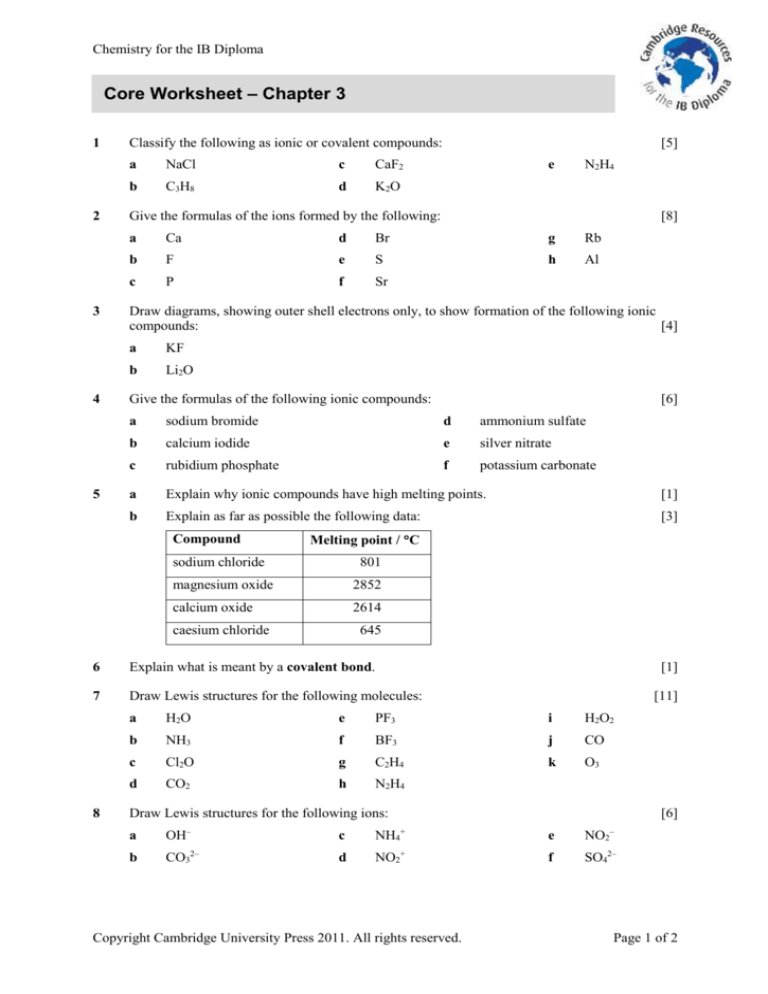
Chemistry for the IB Diploma
Core Worksheet – Chapter 3
1
2
3
4
5
Classify the following as ionic or covalent compounds:
a
NaCl
c
CaF2
b
C3H8
d
K2O
e
N2H4
Give the formulas of the ions formed by the following:
[8]
a
Ca
d
Br
g
Rb
b
F
e
S
h
Al
c
P
f
Sr
Draw diagrams, showing outer shell electrons only, to show formation of the following ionic
compounds:
[4]
a
KF
b
Li2O
Give the formulas of the following ionic compounds:
[6]
a
sodium bromide
d
ammonium sulfate
b
calcium iodide
e
silver nitrate
c
rubidium phosphate
f
potassium carbonate
a
Explain why ionic compounds have high melting points.
[1]
b
Explain as far as possible the following data:
[3]
Compound
Melting point / C
sodium chloride
801
magnesium oxide
2852
calcium oxide
2614
caesium chloride
645
6
Explain what is meant by a covalent bond.
7
Draw Lewis structures for the following molecules:
8
[5]
[1]
[11]
a
H2O
e
PF3
i
H2O2
b
NH3
f
BF3
j
CO
c
Cl2O
g
C2H4
k
O3
d
CO2
h
N2H4
Draw Lewis structures for the following ions:
–
[6]
+
–
a
OH
c
NH4
e
NO2
b
CO32–
d
NO2+
f
SO42–
Copyright Cambridge University Press 2011. All rights reserved.
Page 1 of 2
Chemistry for the IB Diploma
9
10
Work out the shapes and predict bond angles for the following molecules:
[22]
a
H2O
e
PF3
i
H2O2
b
NH3
f
BF3
j
O3
c
Cl2O
g
C2H4
k
H2S
d
CO2
h
N2H4
Predict the shapes and suggest bond angles for the following ions:
a
CO32–
c
NO2+
b
NH4+
d
NO2–
[8]
11
Explain what is meant by electronegativity.
[1]
12
Select the polar molecules from the following list. For the polar molecules draw diagrams
showing the dipoles.
[8]
H2O
PF3
13
14
16
Cl2O
H2
CF4
N2
CO2
O3
Br2 and ICl have roughly the same relative molecular masses. Predict and explain which
has the higher boiling point.
[4]
The boiling points of the hydrides of group 5 are shown in the table below. Plot this data on
a suitable graph and explain the trends shown.
[5]
Compound
15
NH3
BF3
Boiling point / C
NH3
–33
PH3
–88
AsH3
–62
SbH3
–18
a
Draw a sketch of the structure of diamond and use it to explain why diamond has
a very high melting point.
[4]
b
Explain why silicon has a lower melting point than diamond.
[3]
c
Explain how the structure of graphite differs from that of diamond.
[4]
a
Explain, using a diagram, the bonding in a metal such as sodium.
[2]
b
Explain why magnesium has a higher melting point than sodium.
[4]
Copyright Cambridge University Press 2011. All rights reserved.
Page 2 of 2








